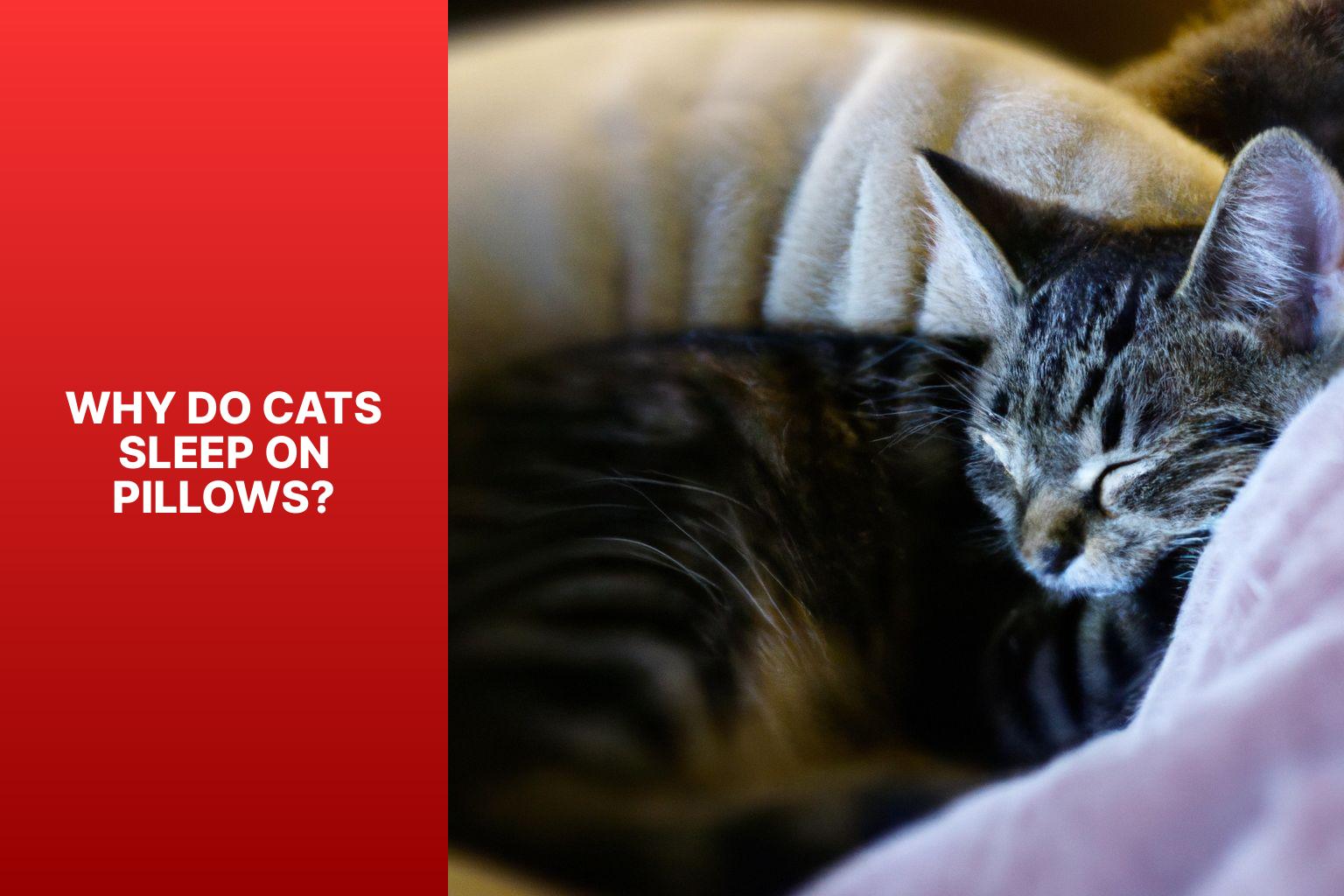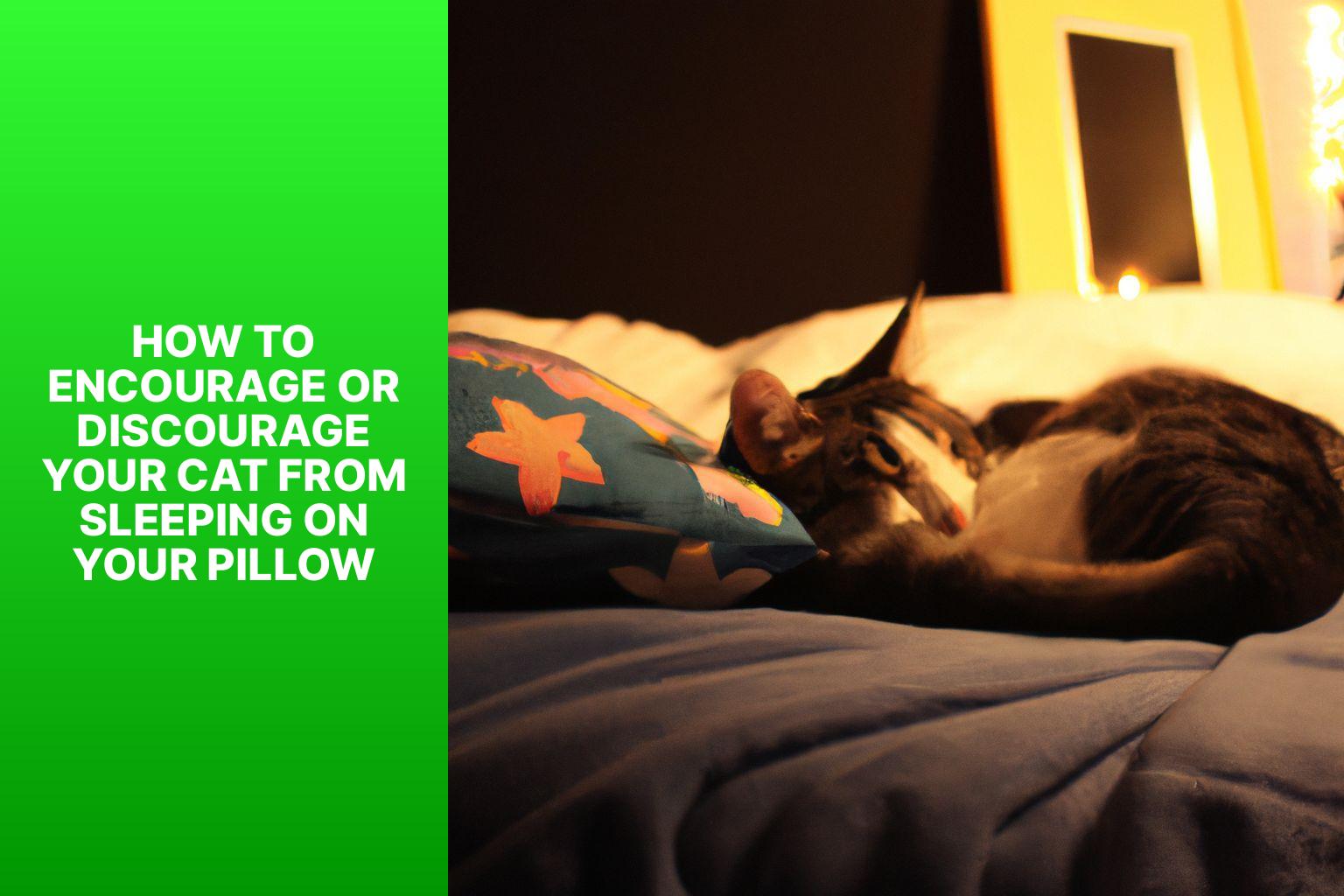Understanding Cat Behavior
Cats have a unique way of behaving and interacting with their surroundings. One peculiar behavior that many cat owners may have experienced is their cat sleeping on their pillow. While this may seem like an odd choice of sleeping spot, it is not uncommon for cats to exhibit this behavior. To understand why cats sleep on pillows, we need to delve into their natural instincts and behaviors.
Why Do Cats Sleep on Pillows?
- Comfort and Warmth: Cats are instinctively drawn to soft and warm surfaces, and a pillow can provide both. The plushness and warmth of a pillow make it an attractive spot for a cat to curl up and relax.
- Bonding and Security: Sleeping on their owner’s pillow allows cats to bond with their humans and feel secure. Being close to their owner’s scent and presence can provide a sense of comfort and safety for cats.
- Territory Marking: Cats have scent glands in their cheeks and paws, and by sleeping on your pillow, they are marking it with their scent. This territorial behavior is a way for cats to claim their territory and assert their ownership over their sleeping spot.
What Does It Mean When a Cat Sleeps on Your Pillow?
When a cat chooses to sleep on your pillow, it can be seen as a sign of affection and trust. Cats often choose to sleep in close proximity to their owners to seek comfort, security, and a sense of belonging. It shows that your cat feels a strong bond with you and considers you a part of their social group.
How to Encourage or Discourage Your Cat from Sleeping on Your Pillow
If you enjoy having your cat sleep on your pillow, there’s no need to discourage this behavior. If you prefer that your cat finds an alternative sleeping spot, there are a few strategies you can try:
- Providing an Alternative Sleeping Spot: Make sure your cat has a cozy and comfortable bed or blanket of their own. Encourage them to sleep there by placing treats or toys nearby.
- Using Deterrents: If you want to discourage your cat from sleeping on your pillow, you can use deterrents like aluminum foil, double-sided tape, or a mild citrus scent on the pillow. Cats are usually sensitive to these textures and smells and may choose to avoid the area.
Creating a Comfortable Sleeping Environment for Your Cat
To ensure that your cat is content and comfortable in their sleeping spot, consider the following:
- Provide a Cozy Bed or Blanket: Cats appreciate having a soft and cozy bed or blanket where they can curl up and relax.
- Adjust the Room Temperature: Maintain a comfortable room temperature for your cat, as extreme heat or cold can affect their sleep quality.
- Minimize Disturbances and Noise: Create a peaceful environment for your cat by minimizing noise and disturbances that may disrupt their sleep.
- Make Sure Your Cat Feels Safe and Secure: Create a safe and secure environment for your cat by providing hiding spots, vertical spaces, and enough litter boxes throughout your home.
By understanding why cats sleep on pillows and implementing strategies to cater to their needs, you can create a harmonious sleeping routine for both you and your feline companion.
- Cats sleep on pillows for comfort and warmth
- Cats sleeping on your pillow may indicate a bond and sense of security
- Cats sleep on pillows to mark their territory
- Encourage your cat to sleep elsewhere by providing alternative spots
- Use deterrents to discourage your cat from sleeping on your pillow
- Create a comfortable sleeping environment for your cat with a cozy bed or blanket
- Adjust the room temperature to make it ideal for your cat’s sleep
- Minimize disturbances and noise to help your cat sleep better
- Ensure your cat feels safe and secure in the sleeping area
Understanding Cat Behavior
Understanding Cat Behavior
Cats have unique behaviors that can puzzle their owners. Understanding cat behavior helps us bond better and provide appropriate care.
- Body language: Cats use their body to communicate. Pay attention to tail position, ears, and posture to determine their mood.
- Vocalizations: Cats meow, purr, hiss, and growl to express needs or feelings. Each vocalization has a different meaning.
- Grooming: Cats groom themselves not only to keep clean but also to relax and show contentment.
- Play behavior: Cats play to exercise, relieve stress, and enhance hunting skills. Provide interactive toys to engage their natural instincts.
Understanding cat behavior can be eye-opening. I had a cat named Whiskers who always followed me. At first, it was cute, but then I realized she was marking her territory and claiming me as her own. It showed affection and loyalty. Understanding this behavior made me appreciate her more and give her the love and attention she craved.
By observing and interpreting cat behaviors, we can cultivate a strong bond and ensure their well-being. Remember, each cat is unique, and understanding their behavior is a continuous learning process.
Why Do Cats Sleep on Pillows?
Photo Credits: Www.Catcornerblog.Com by Sean Miller
Ever wondered why your feline friend insists on claiming your pillow as their own? In this section, we’ll uncover the fascinating reasons behind why cats have a special affinity for snoozing on our pillows. From seeking comfort and warmth to establishing a deeper bond with their humans, and even marking their territory, we’ll explore the intriguing factors that drive our furry companions to choose our pillows as their preferred napping spot. Get ready to discover the secrets of your cat’s pillow obsession!
1. Comfort and Warmth
Cats primarily choose to sleep on pillows for comfort and warmth as they are instinctively drawn to soft surfaces. The softness of the pillows provides the perfect cushion for them to relax and sleep on, fulfilling their need for comfort.
Pillows help in regulating the body temperature of cats by retaining their body heat. This makes pillows a warm and snug place for cats to curl up in, especially during colder weather or in air-conditioned rooms.
In addition to providing comfort and warmth, pillows also carry familiar scents. Your pillow carries your scent, which gives a sense of security and familiarity for your cat.
When your cat sleeps on your pillow, it allows them to be close to you while you sleep, strengthening the bond between you and your feline companion.
It’s important to note that every cat is different, and their preferences may vary. If you prefer your cat not to sleep on your pillow, make sure to provide alternative comfortable sleeping spots, such as a cozy cat bed or blanket. Regular washing of your pillow will help remove any cat dander or allergens that may accumulate.
2. Bonding and Security
Bonding and Security:
– Bonding: When a cat sleeps on your pillow, it strengthens the bond between you and your cat. Cats are social animals and seek warmth and comfort from their human companions. Sleeping on your pillow allows them to be close to you.
– Security: Cats like to sleep in safe and secure places. Your pillow provides a high and protected spot where they feel safe from potential dangers. Sleeping on your pillow helps them relax and gives them a sense of security.
To enhance the bonding and security between you and your cat, create a designated sleeping space near your pillow. Place a cozy and comfortable bed or blanket in that spot to provide them with a safe and familiar place to sleep. This will give your cat the security they seek while ensuring that you can still enjoy a good night’s sleep.
3. Territory Marking
Territory marking is a behavior that cats use to establish their presence and mark their territory. Here is a list of behaviors related to territory marking in cats:
1. Scratching: Cats have scent glands in their paws and scratch to leave scent marks and visual signs of their presence. They may scratch furniture, walls, or other objects to mark their territory.
2. Urine Spraying: Cats mark their territory by spraying urine, typically on vertical surfaces like walls or furniture. This behavior is more common in unneutered males but can be seen in both sexes.
3. Rubbing: Cats have scent glands on their face, chin, and body. They rub against objects to deposit their scent and mark their territory. You may notice your cat rubbing against furniture, walls, or even your legs.
4. Chin and Cheek Rubbing: Cats also rub their chin and cheeks on objects to mark their territory. This behavior is often seen when they rub against corners of walls or furniture.
One evening, I noticed my cat repeatedly scratching the side of the couch. At first, I thought it was normal scratching behavior, but then I realized that she was engaging in territory marking. She only scratched that specific spot, making it her designated scratching area. To discourage her from damaging the couch, I provided a scratching post nearby. She quickly understood and started using the post instead, leaving the couch untouched. Understanding her territory marking behavior allowed me to redirect it and provide her with an appropriate outlet for her instincts. This helped maintain harmony between our cat and our furniture.
What Does It Mean When a Cat Sleeps on Your Pillow?
When a cat sleeps on your pillow, it means they feel comfortable and safe in your presence. Cats seek warmth and security, and your pillow provides both. Sleeping on your pillow allows them to be close to you and your scent, which comforts and reassures them. It also signifies a bond and trust between you and your cat. Cats are naturally drawn to soft and cozy surfaces, and your pillow fits perfectly. They may also sleep on your pillow to mark it as their territory and claim ownership. So if your cat chooses to sleep on your pillow, it’s a sign of affection and a desire to be close to you. Embrace this special moment and enjoy the warmth and love your furry friend brings. What Does It Mean When a Cat Sleeps on Your Pillow?
How to Encourage or Discourage Your Cat from Sleeping on Your Pillow
Photo Credits: Www.Catcornerblog.Com by Sean Wilson
Tired of waking up with a cat-sized pillow hog? Discover how to reclaim your pillow and get a good night’s sleep with these simple strategies. We’ll explore providing alternative sleeping spots that will entice your furry friend away from your pillow. Plus, learn about effective deterrents that will discourage your cat from claiming your pillow as their own. Say goodbye to pillow battles and hello to restful nights!
1. Providing an Alternative Sleeping Spot
Providing an Alternative Sleeping Spot
When your cat insists on sleeping on your pillow, it is important to offer alternative sleeping spots to discourage this behavior. Here are some tips:
1. Offer a cozy cat bed: Ensure that you have a comfortable bed designed specifically for cats near your pillow. Choose a bed with soft cushioning and warm materials, making it appealing and inviting for your feline friend.
2. Create a designated cat sleeping area: Set up a space in your home where your cat can sleep undisturbed. This can be a quiet corner with a soft blanket or a cozy cat tree with a comfortable sleeping perch.
3. Provide a variety of resting options: Make sure to offer different types of pet beds such as open beds, enclosed caves, or hammocks. This will allow your cat to choose the spot they prefer.
4. Ensure the alternative sleeping spot meets their needs: Take into consideration your cat’s preferences for warmth, height, and privacy. Some cats may prefer warmer spots, while others like to be elevated to survey their surroundings.
5. Make the alternative spot appealing: Sprinkle some catnip or place a familiar blanket on the alternative sleeping spot to make it more enticing. You can also place their favorite toys nearby to create a positive association.
By providing an alternative sleeping spot that meets your cat’s needs and preferences, you can encourage them to sleep in their own space instead of on your pillow.
2. Using Deterrents
– Scent deterrents: To discourage your cat from sleeping on your pillow, use scent deterrents. Cats have a strong sense of smell, and certain scents can be unpleasant for them. Try citrus-scented air freshener or essential oils like lavender or eucalyptus, as cats dislike these scents.
– Physical barriers: Another effective deterrent is creating physical barriers on your pillow. Place double-sided tape or aluminum foil on your pillow, as cats dislike the texture and will avoid jumping on it. Use a pillowcase with a different texture that your cat finds uncomfortable.
– Motion-activated deterrents: These can also discourage your cat from sleeping on your pillow. These devices emit a sound or harmless burst of air when your cat comes near, startling them and making them avoid the area.
Pro-tip: Consistency is key when using deterrents. Consistently apply scent or physical barriers on your pillow to reinforce that it’s not a desirable sleeping spot. Provide your cat with alternative comfortable and safe sleeping options to redirect their attention away from your pillow.
Creating a Comfortable Sleeping Environment for Your Cat
When it comes to our feline friends, we want them to have the most comfortable sleep possible. In this section, we’ll explore how to create the perfect sleeping environment for your cat. From providing a cozy bed or blanket to ensuring the room temperature is just right, we’ve got you covered. We’ll also discuss the importance of minimizing disturbances and noise, as well as making sure your cat feels safe and secure. So grab a cup of tea and let’s dive into the world of feline sleep!
1. Providing a Cozy Bed or Blanket
When providing a cozy bed or blanket for your cat, it is important to consider the following factors:
- Size: It is crucial to choose an appropriate size, avoiding anything too big or small.
- Materials: It is recommended to opt for soft, plush materials such as fleece or sherpa.
- Thickness: Take into consideration your cat’s preference for cushioning.
- Washability: Look for options that are easy to clean, ensuring convenience.
Pro-tip: If your cat scratches or kneads its bed, it is advisable to provide a separate scratching post or mat.
2. Adjusting the Room Temperature
Adjusting the room temperature for your cat can be easily achieved by taking the following steps:
– Keep the room temperature moderate: Cats are quite sensitive to extreme temperatures. It is best to maintain a room temperature ranging between 68 and 78 degrees Fahrenheit in order to ensure their utmost comfort.
– Use a thermostat: Installing a thermostat will allow you to accurately monitor and control the temperature. This will enable you to effortlessly make adjustments so that your cat neither feels too hot nor too cold.
– Provide heating or cooling options: During colder months, provide your cat with a heating pad or a comfortable heated bed to snuggle up on. On the other hand, in warmer months, consider using a fan or air conditioning to cool down the room if necessary.
– Ensure proper ventilation: Good air circulation is crucial, particularly during hot summer months. To guarantee this, make sure the room has proper ventilation.
– Monitor your cat’s behavior: Paying close attention to your cat’s behavior and body language is vital. If you notice that they seek out warm spots or try to find cooler areas, it may be an indication that the room temperature needs adjustment.
By diligently following these steps, you can effortlessly create a comfortable environment for your beloved cat.
3. Minimizing Disturbances and Noise
Minimizing disturbances and noise is crucial for ensuring your cat’s peaceful sleep. Here are strategies you can use:
1. Keep the environment calm: Avoid loud noises or sudden disruptions that could startle your cat. This includes turning down the volume on the TV or radio and avoiding noisy activities near your cat’s sleeping area.
2. Provide a quiet sleeping space: Create a designated area away from noisy parts of your home. This could be a separate room or a cozy corner where your cat feels safe.
3. Use soundproofing techniques: If you live in a noisy neighborhood or have loud neighbors, consider using soundproof curtains or weatherstripping on doors and windows.
4. Use background noise: Some cats find white noise or calming music soothing. Experiment with different types of background noise to find what works best for your cat. Just ensure it’s not too loud or overwhelming.
By implementing these strategies, you can create a quiet and peaceful sleeping environment for your cat, allowing them to rest undisturbed.
In ancient Egypt, cats were highly revered and considered sacred animals, bringing good luck and protection against evil spirits. Egyptians even took great care to provide a peaceful sleeping environment for their cats by building special pillows adorned with precious materials. These pillows were placed in quiet, secluded areas. This practice reflects the importance of minimizing disturbances and noise to provide a tranquil resting space for cats, a tradition that continues to be significant for cat owners today.
4. Making Sure Your Cat Feels Safe and Secure
Making sure your cat feels safe and secure is crucial for their overall well-being. Here’s how you can achieve this:
1. Create a designated space: Set aside an area where your cat can retreat when they are feeling anxious or scared. This can be a cozy corner with a comfortable bed or blanket.
2. Provide vertical spaces: Cats feel safe when they can observe their surroundings from an elevated position. Install cat trees, shelves, or perches that allow them to climb and have a room view.
3. Ensure hiding spots: Cats seek shelter in small enclosed spaces to feel secure. Provide covered beds, cardboard boxes, or a dedicated cat tent for them to hide in.
4. Maintain a consistent routine: Stick to regular feeding, play, and sleep schedules. This helps cats feel secure and gives them a sense of what to expect.
5. Minimize loud noises: Loud sounds can startle and stress cats. Keep the environment as quiet as possible, especially during rest times. Provide a safe space where they can retreat during unavoidable loud noises.
6. Use pheromone sprays or diffusers: Feliway, a synthetic feline pheromone product, can help create a sense of security. These products mimic the natural pheromones that cats release when they feel safe and content.
7. Give positive reinforcement: Reward calm and confident behavior with treats, praise, and affection. This boosts their confidence and strengthens their sense of security.
By following these steps, you can ensure that your cat feels safe and secure at home, which will contribute to their happiness and overall well-being.
Some Facts About Why Cats Sleep on Pillows:
- ✅ Cats sleep on their owner’s pillows to seek warmth and comfort. (Source: Vocal Cats)
- ✅ Sleeping on pillows allows cats to feel higher up and safer. (Source: Vocal Cats)
- ✅ Cats may sleep on pillows to mark their territory or show affection. (Source: Vocal Cats)
- ✅ Sharing a bed with a cat can have benefits such as improved health and reduced stress. (Source: Dutch)
- ✅ Cats typically sleep for 16-20 hours a day and are most active during dusk and dawn. (Source: Dutch)







